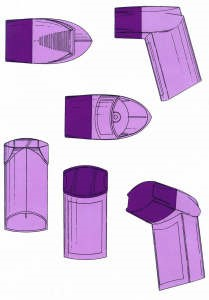Success for Glaxo’s 3D mark for purple asthma inhaler
On 24 May 2023, the European Union (EU) General Court annulled the decision of the Board of Appeal of EUIPO to invalidate Glaxo’s three-dimensional (3D) mark (case T-477/21).
This article first appeared in WTR Daily, part of World Trademark Review, in June 2023. For further information, please go to www.worldtrademarkreview.com.
Background
Glaxo Group Limited’s (Glaxo) 3D mark was filed on 12 April 2001 for among others, “pharmaceutical preparations for the treatment of respiratory ailments” in class 5 and “inhalers” in class 10. The colours “lilac” and “deep purple” were claimed.

Background to the dispute
Glaxo’s three-dimensional mark was filed on 12 April 2001 for i.a. “pharmaceutical preparations for the treatment of respiratory ailments” in class 5 and “inhalers” in class 10. The colours “lilac” and “deep purple” were claimed.
The invalidity proceedings were initiated almost ten years ago by Cipla Europe NV (Cipla), a Belgian provider of medicinal products. Cipla Europe’s Indian-based parent company is known for the production of generics. Cipla entered the respiratory market in the European Union with an anti-asthma inhaler almost ten years ago, around the time when the application for invalidity was filed.
In parallel to the invalidity proceedings, in September 2015 Glaxo filed a trade mark for the colour “purple” (pantone 2587 C) for the same goods in classes 5 and 10. The mark was rejected by the EUIPO due to descriptiveness. This was confirmed by the General Court on 09 September 2020 (case T-187/19). In the invalidity proceedings against Glaxo’s 3D mark, the Board of Appeal referred to this decision when assessing the distinctiveness of the contested mark.
The invalidity proceedings before the EUIPO
The Cancellation Division of the EUIPO granted the application for a declaration of invalidity, deciding that Glaxo’s three-dimensional mark was non-distinctive. Glaxo filed an appeal against the decision of the Cancellation Division, but the Board of Appeal dismissed Glaxo’s appeal. Glaxo then filed an appeal with the General Court.
The decision of the General Court
The decision of the General Court mainly addresses the burden of proof and the relevant date for assessing the validity of the contested mark in invalidity proceedings.
In invalidity proceedings, the burden of proof lies on the invalidity applicant and the relevant date is the filing date of the contested mark. Evidence postdating the filing date can in principle be taken into account if proper reasoning is provided allowing conclusions regarding the situation at the filing date. If, and to what extent, evidence postdating the relevant date can be taken into account will mainly depend on the date of the evidence, the type of mark and the developments and trends in a particular industry.
In this particular case, the General Court considered that the Board of Appeal’s reasoning was contradictory.
The Board of Appeal had first found that the invalidity applicant had not demonstrated that Glaxo’s3D mark was devoid of distinctive character at the relevant filing date. However, the Board of Appeal subsequently came to the conclusion that use of colours for medicinal products for the treatment of asthma was descriptive. According to the Board of Appeal, these findings were confirmed by the judgment of the General Court regarding Glaxo’s colour mark (case T-187/19).
In the view of the General Court, this was in clear contradiction to what had been previously stated by the Board of Appeal, resulting in the Board of Appeal’s failure to state reasons.
On the one hand, the Board of Appeal had first stated that the pharmaceutical sector changed permanently and that the perception of the goods could change over ten-year periods or longer periods. According to the Board of Appeal, such a situation would make it difficult to establish the validity of the information back in time. Evidence bearing a date subsequent to, but close to, the relevant date, could potentially be relevant for assessing the validity of the contested mark at the relevant date. The Board of Appeal did however not identify and examine that evidence. On the other hand, the judgment cited by the Board of Appeal in case T-187/19 concerned a mark filed almost fourteen years after Glaxo’s 3D mark was filed. The Board of Appeal, without providing any further reasoning, simply stated that the principles established in case T-187/19 for the same market in 2015 (the filing date of Glaxo’s colour mark) would be equally applicable to the earlier date of 2001 (the filing date of Glaxo’s 3D mark).
In short
- The European Union Intellectual Property Office (EUIPO) granted Cipla’s application for a declaration of invalidity of Glaxo’s 3D mark, covering goods in classes 5 and 10.
- The General Court found that the Board of Appeal had failed to fulfil its obligation to state reasons due to contradictory reasoning in its decision.
- The Board of Appeal, without providing any further reasoning, had simply stated that the principles established in case T-187/19 for the same market in 2015 would also be applicable to the earlier date of 2001.
